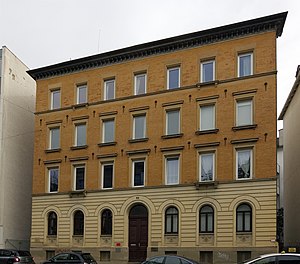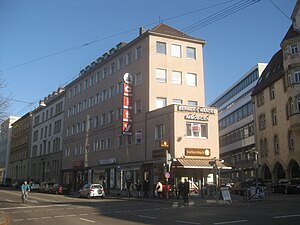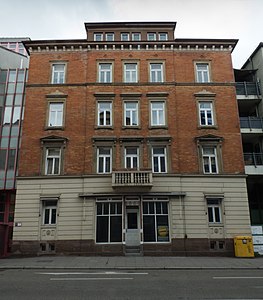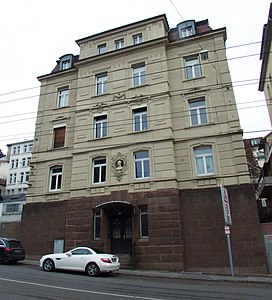Georg Schöttle
Georg Schöttle (born October 15, 1823 in Stuttgart , † January 10, 1897 in Stuttgart) was a Stuttgart building contractor, furniture manufacturer and initiator of the Stuttgart horse-drawn railway.
Early years
Georg Heinrich Schöttle was born on October 15, 1823 in Stuttgart at Esslinger Straße 10 / corner Wagnerstraße as the youngest of 8 children. His father Karl Friedrich Schöttle ran a flour shop and a wine tavern in the house and "lived with his family in simple circumstances". His mother was Christiane Friederike Raith, the daughter of a flour trader.
He completed elementary classes at the orphanage school in the nearby orphanage on Charlottenplatz , then attended the construction school in Stuttgart, a forerunner of the Polytechnic, and from 1837 to 1840 apprenticed to the master mason, Weiss, which he completed with the journeyman's examination. Georg Schöttle married Friedrike Caroline Class (1826–1903) in 1851, who gave him 14 children.
Working life

After completing his apprenticeship, Georg Schöttle went on the roll and worked as a bricklayer in the construction of the basilica of the St. Bonifaz Abbey in Munich, as a foreman in the construction of the Palais Thermal in Bad Wildbad and as a construction manager for buildings in Stuttgart and Tübingen. He gained experience in railway construction as a site manager on the Ulm – Friedrichshafen railway line .
Umbrella business
In the year of his marriage in 1851, Georg Schöttle opened an umbrella shop at Breiten Strasse 9 or 11 in Stuttgart, "which his practical and hardworking wife successfully ran for several years". The business included its own production of umbrellas and sunshades based on models that Georg Schöttle had brought back from one of his trips to Paris.
Railway construction
In the 1850s, Georg Schöttle started his own business as a building contractor. Among other things, he took over the construction of the Retzbach – Karlstadt – Wernfeld and Schweinfurt – Schonungen railway lines . From 1854 to 1857 he built the Rheineck – Rorschach – St. Gallen with the famous Goldach Viaduct , which was built according to the plans of the Stuttgart architect Karl Etzel . In 1857, near Rorschach, he built the New Zealand villa on Lake Constance for his family, which the family used as a summer holiday home after his return to Stuttgart.
In the 1850s Georg Schöttle made trips to Paris and London, where he found out about new technical developments. As a modern entrepreneur, he used the latest technical tools that he had come across on his travels. He was the first building contractor to introduce locomotives for earthmoving and the practical use of electric arc lights. After the #Baufabrik was founded in 1859, Georg Schöttle continued to take on projects in railway construction, such as the Cannstatt-Waiblingen , Calw-Teinach , Darmstadt-Weinheim and Elberfeld-Odenkirchen routes .
Construction factory
|
|
|
In 1859 Georg Schöttle acquired the joint stock brewery building at Wilhelmstrasse 14. He rebuilt the large, former brewery building and expanded it with additional buildings. His company buildings formed the so-called construction factory, in which he prefabricated components and entire houses based on English models. In the large company, which gave its owner the name "Bau-Schöttle", craftsmen of all trades worked that were needed for new construction and for the repair of existing buildings. Missing trades were recruited on a case-by-case basis. In the summer of 1861 Georg Schöttle employed between 1200 and 1500 people. The tech-savvy Georg Schöttle used modern steam engines in his factories. In 1861 he registered a patent for a kneading and squeezing machine.
The company also had other businesses, including two quarries, a parquet factory that later developed into an important furniture factory, a steam sawmill (1865) and a steam brick that was owned by the "Stuttgart real estate and construction business", a predecessor company, in 1872 from HeidelbergCement .
By 1870, the construction factory in Stuttgart had built around 20 factory buildings and public buildings, including the old Stuttgart synagogue , the second Stuttgart central train station and the Stuttgart slaughterhouse. The company's main business was building houses to order and for resale on its own account. The construction factory built around 80 houses by 1870.
| → Georg Schöttle's residential buildings in Stuttgart |
|
|
Georg Schöttle junior (1851–1939) graduated from the Polytechnic in Stuttgart, where he graduated as an engineer. He gained practical experience in railway construction and founded the Schöttle & Schuster company in 1875 together with the government master builder Friedrich Schuster (1846–1910), which was active in railway construction and fortress construction. Among other things, Schöttle & Schuster was involved in the construction of the fortress structures in Strasbourg , Spandau and Küstrin .
Nothing is known about the development of Georg Schöttle senior's construction company from 1870 onwards. From 1886 only the entry “Georg Heinrich Schöttle, Architect” appears in the address books without the addition of a building contractor or construction business. Apparently the construction factory had ceased operations.
Furniture factory
In line with his claim to deliver turnkey houses, Georg Schöttle founded a parquet flooring factory , a sawmill, a joinery and a locksmith's shop at the same time as his construction factory . The necessary resources for furniture production were available to him. In 1867 Georg Schöttle was listed in the address book as “construction business, acquisition and sale of building requisites and household furnishings”, a reference to furniture production that was to become more and more important. In 1870 the parquet flooring factory was renamed the Stuttgart furniture and parquet flooring factory, and later the Stuttgart furniture factory Georg Schöttle. In 1893 the furniture factory was awarded the title of Royal Court Supplier. The furniture factory was one of the most important factories of its kind in Stuttgart. An industry expert wrote in 1896:
- “One of the largest establishments in Stuttgart is Georg Schöttle's furniture factory. Their activity begins with the processing of the logs with full frames and pendulum saws. Two hundred workers are at work alongside an abundance of machine tools to make splendid forms out of the raw wood. "
Georg Schöttle ran two furniture stores with a sales room and interior art exhibition in Stuttgart, one at Eberhardstrasse 65 and one at Eberhardstrasse 28 ( → photo ), where the Petersburger Hof restaurant was also located. The Schöttle furniture factory enjoyed a nationwide reputation. She took part in many exhibitions, including the world exhibitions in Vienna in 1873, Philadelphia in 1876, St. Louis in 1904 and in Brussels in 1910.
In the Art Nouveau era, the Schöttle furniture factory was a progressive manufacturer of furniture that was manufactured using the xylektypom process invented by the J. Buyten and Sons furniture factory in Düsseldorf . The process enabled fillings to be mechanically decorated with attractive wood grain reliefs. Important artists provided designs for xylektypom furniture, such as Hans Eduard von Berlepsch-Valendas with furniture for the First World Exhibition of Applied Arts in Turin in 1902 and Bernhard Pankok , who designed the Württemberg music room for the World Exhibition in St. Louis. However, after a decade, the xylek typom fell out of fashion.
| → Furniture by Georg Schöttle at the 1904 World Exhibition |
|
|
Horse tram
During one of his trips to Paris, Georg Schöttle also got to know the operation of the horse-drawn railway , which had existed since the end of 1853 . Just as he had already demonstrated his open-mindedness for technical innovations when building the railway , he was now enthusiastic about building a horse-drawn railway in Stuttgart. The almost flat path from the city center to the baths in Berg and Cannstatt , which was heavily frequented by pedestrians, riders and carriages, especially in summer, seemed to him a suitable route for a horse-drawn tram.
His request for permission to build a horse-drawn tram was approved by the Royal Ministry of the Interior in 1862. He secured the provision of the necessary funds for the construction of the horse-drawn railway by founding the public limited company of the Stuttgarter-Pferde-Eisenbahn-Gesellschaft with an initial capital of 350,000 guilders (→ invitation to subscription ). Since the route to Berg had to cross Villastrasse, the path from the Lower Palace Gardens to the royal Villa Berg , the city blocked his plans until he obtained the approval of King Wilhelm I personally. Negotiations with the city about the design of the horse-drawn tram concession still dragged on until 1868.
In 1868, Georg Schöttle and his construction company built the first section of the horse-drawn tram from today's main state archive to Berg and a year later to the Wilhelmsbrücke in Cannstatt. The horse-drawn tram was very popular with the population. The route network and the resources of the horse tram were constantly expanded in the following years. In 1884 another horse tram was founded, which was combined with the previous horse tram in 1889 to form the Stuttgart tram company that still exists today .
Retirement
In the 1870s, Georg Schöttle withdrew from active business as a silent partner for health reasons. In retirement, he ran his winery in Mönchshalde, which he expanded as a model business and research institute for local wine culture. His son Georg (1851–1939) took over the management of the construction company, and his son Karl (1855–1933) took over the management of the furniture and parquet flooring factory. Georg Schöttle died in Stuttgart in 1897 after a stroke at the age of 73. He was buried in Section 2 of the Prague Cemetery in a family grave with an obelisk and a fence. His wife survived him by 6 years. She died in 1903 at the age of 77 and was also buried in the family grave.
After Georg Schöttle's death, his shares in the furniture factory were passed on to members of his family. In the same year the family set up the Georg Schöttle Foundation "for the benefit of the workers employed in the Georg Schöttle furniture factory in Stuttgart". In 1927, the location at Eberhardstrasse 28 was given up as the building was replaced by a new building for the Schocken department store. In 1933 the factory was relocated to Waiblingen (and given up in 1978), the sales room and exhibition rooms remained at Eberhardstrasse 65. In 1970, the entire company property of the Stuttgart furniture factory was transferred to the Stuttgart family Heinrich Waiblinger junior while retaining the company name. sold. Until 1982, the furniture factory of the Stuttgart furniture factory existed in the building Eberhardstrasse 65, which it shared with the carpet gallery from 1977.
patriotism
In 1930 Eugen Dolmetsch wrote about Georg Schöttle in his life picture: “One of the noble features of his character was a deep sense of home and a self-sacrificing love of the country.” In an effort to plant this love of fatherland in the hearts of young people, Schöttle founded a youth armed forces for boys in 1863 together with like-minded people between the ages of nine and fourteen. It consisted of 100 "young men" who were divided into a "company of infantry with small rifles and a battery of artillery with four small-caliber cannons and a band". The youth armed forces did not last long, they disbanded before 1870.
The state of Württemberg mobilized its troops on July 17, 1870 for the Franco-German War . Georg Schöttles eldest son, the 19-year-old Georg (1851–1939) volunteered for the war. 47-year-old Georg Schöttle also wanted to make a contribution. The Württemberg troops suffered from a shortage of "woolen waistbands, shirts and socks". The Stuttgart medical association put together around 70 boxes and kegs with clothing, bandages, wine, brandy and tobacco from its supplies, which were supposed to bring relief to the soldiers at the front. Georg Schöttle and the Stuttgart industrialist Gustav Siegle took over the transfer and led the 8 freight cars to the headquarters of the Württemberg field division in Champagne, some 400 kilometers away, where they arrived on August 21, 1870.
Memberships
- 1859: Masonic lodge to the 3 cedars.
- 1868: Initiator and shareholder of the Stuttgart Horse Railway Company.
- 1869: Co-founder of the South German Society for Railway Construction and Railway Requirements, Stuttgart.
Honors
- Knight's Cross 1st Class of the Order of Frederick
- Order of Olga .
- Ludwig Medal .
- In 1930 Schöttlestrasse in Stuttgart- Degerloch was named after Georg Schöttle.
literature
General
- E. Brösamlen: The beautiful Stuttgart mountain. A home book. Stuttgart 1939, pp. 37-39.
- On your own. A picture of life from old Stuttgart (Georg Schöttle). In: Eugen Dolmetsch: Pictures from Old Stuttgart. Retold and self-experience. Stuttgart 1930, pp. 24-37.
- Ulrich Gohl: The "father" of the Stuttgart horse-drawn tram. In: Stuttgarter Zeitung online, November 15, 2012, pdf .
- Ulrich Gohl: Made in S-Ost: manufacturing companies in the east of Stuttgart from the beginning until today. Stuttgart: Verlag im Ziegelhaus, 2016, p. 213.
- Georg Heinrich Schöttle: 1823–1897. Stuttgart, 1897.
- Foundation provisions for the Georg Schöttle Foundation for the benefit of the workers employed in the Georg Schöttle furniture factory in Stuttgart. Stuttgart, 1897.
- Fifty-year anniversary of Schöttle & Schuster. A look back at their development from 1875 to 1925. Berlin, April 1, 1925. Berlin 1925.
Horse tram
- Gottfried Bauer; Ulrich Theurer; Claude Jeanmaire: Stuttgart trams. A documentation about the tram lines from 1868–1975. Villigen 1976.
- The Stuttgart horse-drawn railway. In: Eugen Dolmetsch: Pictures from Old Stuttgart. Retold and self-experience. Stuttgart 1930, pp. 38-65.
- Kaiser: The Stuttgart Horse Railway. Stuttgart: Kohlhammer, 1885, pdf .
- Rolf Kern: Has someone got on, please? : an anecdotal chronicle about the trams in Stuttgart and elsewhere in the development from yesterday to today. Stuttgart: self-published, 1978.
- 60 years of Stuttgart trams 1868–1928. Stuttgart 1928.
swell
- A construction factory. In: Österreichischer Volkswirth: Wochenblatt für Gold-. Securities and goods traffic, communications, industry, agriculture and politics, Volume 5, 1862, p. 55, pdf .
- Christine Breig: The construction of villas and country houses in Stuttgart 1830–1930. An overview of the various implementations and changes in the villa building type in Stuttgart. Stuttgart 2004, pp. 262–264 (construction of the Herdweg 22 house by Georg Schöttle).
- Richard Calwer: The decline of the carpentry trade. In: Die Neue Zeit, Volume 15, Volume 2, 1896–97, Number 36, pp. 293–301, here: 298, pdf .
- Family Register Stuttgart , Volume 4, pp. 976, 1109, 1110, Volume 13, p. 614, Volume 29, p. 866.
- Konrad Lange: Bernhard Pankok. / Walter Klein: The Württemberg music room in St. Louis. In: Stuttgarter Mitteilungen über Kunst und Gewerbe, 1904/1905, issue 3, pp. 113–160, frontispiece, 111–112, (furniture by Georg Schötter), pdf .
- Karlheinz Mämecke: The golden book of the old Stuttgart companies. Stuttgart: Daco-Verlag, 1956, p. 72 (Karl Schoettle).
- Wolfgang Müller: Stuttgart in old views. Zaltbommel 1979, plate 60.
- Heinz H. Poker: Chronicle of the City of Stuttgart 1970–1972. Stuttgart: Klett-Cotta, 1989, p. 109 (Karl Georg Schoettle).
- [Freight shipment of the medical association for the Württemberg field division]. In: Schwäbischer Merkur / Schwäbische Kronik, August 17, 1870, p. 2321, August 27, 1870, p. 2387, pdf .
- State capital Stuttgart, Office for Urban Planning and Urban Renewal, Lower Monument Protection Authority (Hrsg.): List of cultural monuments. Immovable architectural and art monuments, Stuttgart 2008, pdf .
- Stuttgart address books, 1800–1925 , online .
Web links
Footnotes
- ↑ #Dolmetsch 1930.1 , p 24, 115-116.
- ↑ #Family register .
- ↑ #Family register .
- ↑ #Dolmetsch 1930.1 , pp 24-26. - Georg Schöttle worked on sections of the route in Friedrichshafen and Laupheim.
- ↑ #Familienregister , #Stuttgarter Adressbücher 1853, #Dolmetsch 1930.1 , p. 29. - Georg Schöttle is listed in the family register in 1851 as an umbrella manufacturer. The umbrella business is mentioned for the last time in the 1853 address book.
- ↑ # Schöttle 1897.1 , pp. 4–5.
- ↑ #Dolmetsch 1930.1 , p. 37.
- ↑ #Dolmetsch 1930.1 , p. 36
- ↑ #Dolmetsch 1930.1 , p. 26.
- ↑ #Dolmetsch 1930.1 , p. 33.
- ↑ #Baufabrik 1862 .
- ↑ Baden-Württemberg State Archives .
- ^ History of the Schelklingen cement works .
- ↑ # Schöttle 1897.1 , p. 9, #Dolmetsch 1930.1 , pp. 31–32, #Baufabrik 1862 .
- ↑ # Schöttle 1925 , # Schöttle 1897.1 , p. 10.
- ↑ #Stuttgart address books .
- ↑ #Calwer 1896 , p. 298.
- ^ The building at Eberhardstrasse 28 was demolished in 1925. The Schocken department store, which opened in 1928, was built on the property. The Schocken department store was replaced in 1960 by the new Horten department store. Today the building is the seat of the Galeria Kaufhof. The house at Eberhardstrasse 65 was the seat of the Schöttle furniture store until 1982 and the carpet gallery from 1977 to 2007. The building is to be converted into the "Eberhardhöfen" in 2018.
- ↑ # Lange 1904 .
- ↑ #Bauer 1976 , pp. 7-10, #Dolmetsch 1930.2 .
- ↑ #Dolmetsch 1930.1 , p. 37, # Schöttle 1897.1 , pp. 10, 14, # family register .
- ↑ # Schöttle 1897.2 .
- ↑ #Poker 1970 .
- ↑ The History of the Carpet Gallery.
- ↑ #Dolmetsch 1930.1 , p. 34.
- ↑ #Dolmetsch 1930.1 , pp. 34–35.
- ↑ # Schwäbischer Merkur 1870 , #Dolmetsch 1930.1 , pp. 35–36.
- ↑ # Schöttle 1897.1 , p. 15.
- ↑ # Schöttle 1897.1 , p. 10.
- ↑ # Schöttle 1897.1 , p. 11.
| personal data | |
|---|---|
| SURNAME | Schöttle, Georg |
| BRIEF DESCRIPTION | Building contractor, furniture manufacturer and initiator of the Stuttgart horse-drawn railway |
| DATE OF BIRTH | October 15, 1823 |
| PLACE OF BIRTH | Stuttgart |
| DATE OF DEATH | January 10, 1897 |
| Place of death | Stuttgart |






















